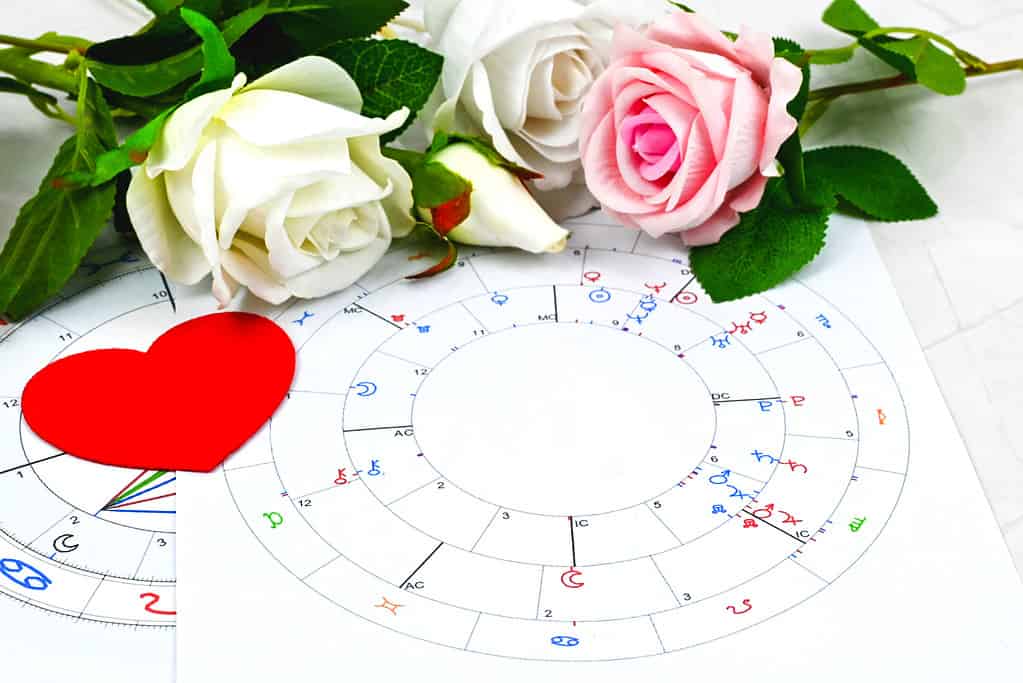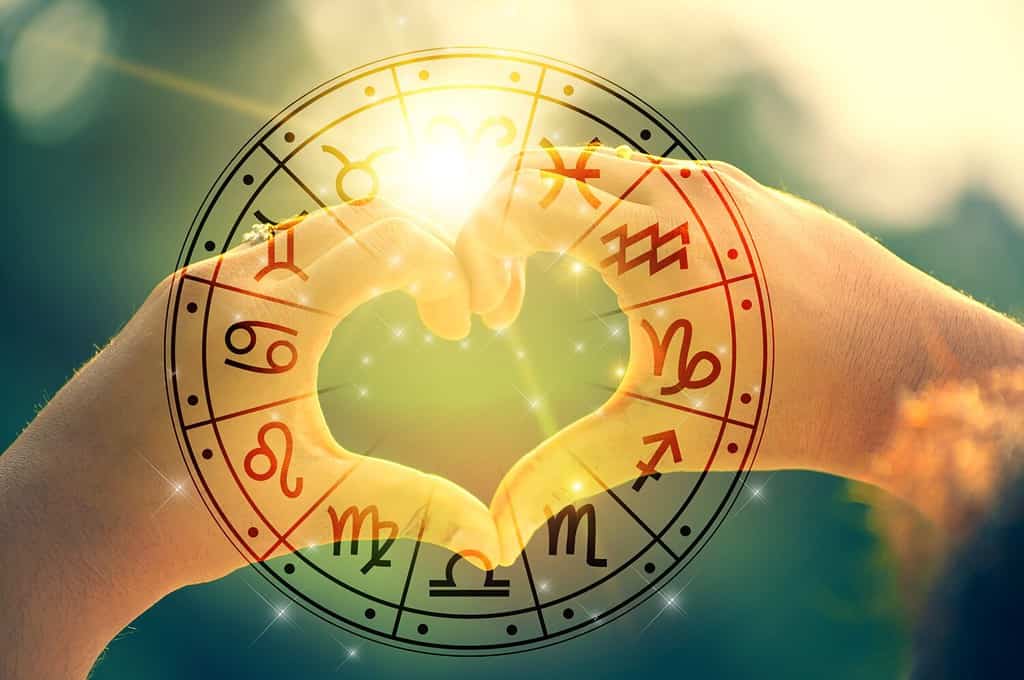Astrological Compatibility: What Is Synastry and How Does it Work?

©Worarat Ngamkamollert/iStock via Getty Images
Synastry is the astrology of relationships. It is an evaluation of the astrological compatibility between two people, whether they are friends, business partners, or lovers. Some people believe that synastry (and astrology in general) is more deterministic, and can tell for certain whether or not two people will get along with each other.
Others believe that synastry is more of a tool to highlight areas where there may be friction and areas that might flow easily in a relationship. The latter people see synastry as a psychological tool that people can use to get along better, work through conflict, and explain the qualities of relationships.
Astrology novices consider only the sun sign when looking at the compatibility of possible dates. However, there is a whole chart to contemplate, which includes every single planet in our solar system, and other important astrological factors. Synastry is the art of comparing two full natal charts.
The Most Important Planets in Synastry
Many astrologers believe that while the whole chart is important when trying to determine compatibility through synastry, there are some planets that have more of a bearing on the potential compatibility of the relationship depending on what type of relationship it is.
The Most Important Planets in Love and Life Partnership Synastry

©buradaki/Shutterstock.com
The most important placements for this type of synastry are the Sun, Moon, Rising, and Venus signs. It’s also important to note the other person’s planets that aspect any of those four.
For example, someone else’s Neptune squaring your Sun may mean that your partner has a one-dimensional attraction to you based on their own illusion about you, rather than who you really are.
Why are the Sun, Moon, Rising, and Venus signs most important in synastry? The first three on this list are known as the “big three” in astrology.
- The Sun represents your overall personality, what drives you, and where you “shine.”
- The Moon represents your inner emotional and subconscious world, and what makes you feel emotionally safe.
- Your Rising Sign represents how people see you and the “mask” you show to the world.
The other important addition to the “big three” in synastry is Venus. This planet represents how you love, how you want to be loved, and how you like to show up in relationships. It also represents how you experience pleasure and sexuality.
The Most Important Planets in Business Partnership Synastry

©WR Studios/Shutterstock.com
When it comes to business partners, the Sun, Moon, and Rising signs are also very important. However, Venus’ importance is highlighted when it comes to love. In business, all planets can be important, but Mars and Saturn are valuable signals for how well you might work with someone.
Mars represents our actions in the world. It may be related to sex, but it also represents your drive, and how you show up to work. Saturn represents our productivity and ambition. It’s easy to see how these two planets would have special importance in a business partnership.
Don’t Forget the Other Planets!

©19 STUDIO/Shutterstock.com
While those four planets and luminaries may be the most important for comparing two peoples’ natal astrology charts, astrologers consider all the planets during a synastry reading.
The Most Important Houses in Synastry
In astrology, the 12 houses represent different areas of your life such as your home, friendships, and career. In synastry, how another person’s planets fall into your houses can have salient information on your compatibility.
The Most Important Houses in Love and Life Partnership Synastry

©Vittorio Gravino/iStock via Getty Images
The 5th, 7th are the most important for dating and romance synastry. The 5th House is about many things, including romance. This house might be most important in the dating phase of a relationship, however, some placements here, like someone else’s Venus in your 5th House, could be a potential sign of a powerful and long-lasting connection.
The 7th House is the house of one-on-one partnerships and is also the house of marriage. Someone else’s planets in your 7th House indicate a natural flow, magnetic attraction, and ease of connection.
The Most Important Houses in Business Partnership Synastry
The 7th House is important in any partnership, including business partnerships. However, for these types of relationships, you should also look at the 10th House of career and public image, and the 2nd House of possessions, values, and money.
Don’t Forget the Other Houses!
Even though the aforementioned houses have specific importance for relationships, the whole natal chart, including every single house (and planet) has bearing in a synastry readings.
How Do Synastry Readings Work?
During a synastry reading, an astrologer (or app) directly compares your natal chart with your potential partner’s. Typically, this looks like a regular natal chart with an additional circle around it. The outer circle represents one partner’s natal chart and the inner circle represents the other’s. With this configuration, it is easy to visually compare the different aspects between two peoples’ planets and see where their planets fall into each other’s houses.
Aspects in a Synastry Reading
Any type of astrology chart has aspects between the planets. These become even more important in a synastry chart as it is comparing where someone else’s planets are in relationship to yours. The most commonly used aspects or “major aspects” are:
- Conjunction: When two planets are close to each other, usually in the same sign, their energies combine and work together.
- Trine: When two planets are 120 degrees (four signs) apart, they are in the same element. A trine’s energy is harmonious and flowing.
- Sextile: When two planets are 60 degrees (two signs) apart, the energy also flows easily.
- Square: When two planets are 90 degrees (three signs) apart, the energy is more challenging and may feel blocked or stuck.
- Opposition: When two planets are opposite each other in a chart, there may be friction. However, this friction will lead to valuable learning experiences.
Less commonly used aspects are called “minor aspects.” You may see them on a synastry chart reading. However, their effects are usually less impactful than those of the major aspects. They include:
- Quintile: When two planets are 72 degrees apart (1/5 of the chart), energy may flow, especially towards a creative experience.
- Bi-quintile: When two planets are two Quintiles (144 degrees) apart, the energy flows similarly to a Quintile.
- Semi-square: When two planets are 45 degrees apart (half a square), the blockage is similar to a Square, but less powerful.
- Inconjunt (Quinqunx): When two planets are 150 degrees apart (five signs), they are completely missing each other, leading to potential challenges.
- Sesquiquadrate (Sesquisquare): When two planets are 135 degrees apart, they may create a long-term low level conflict or tension.
Where Can You Get A Synastry Reading?

©Andrey_Popov/Shutterstock.com
Most professional astrologers also give synastry readings and some even specialize in it. Professional astrologers see clients in person, and many also work on the phone or via video chat. To find a reputable astrologer, ask friends for recommendations or read reviews online.
There are also several premium apps or websites where you can compare two peoples’ astrology charts. While many astrology apps are free, synastry chart comparisons are usually a paid feature because it is a bit more complicated than just pulling up a natal chart. Some apps or websites that offer this feature include:
- Time Passages Pro – $29.99 for iOS App/Android App is free with in-app purchases to unlock all features/$79.99 for Desktop (Windows/Mac)
- AstroGold – $39.99 for iOS App/$26.99 for Android App/$229.99 for Desktop (Mac only)
- iPhemeris – $29.99 for iOS App/$99.99 for Desktop (Mac only)
There are also several websites where you can find a synastry chart without much comparison or evaluation for free. For those who already have some knowledge about astrology, this can be a useful tool.
How to Interpret a Synastry Reading

©sarayut_sy/Shutterstock.com
If you’ve seen a few eyebrow-raising statements in a synastry report, don’t make any rash decisions. First, there are many interpretations of astrology and ways that different astrological aspects can play out. One person’s interpretation is only one possible perspective. It’s impossible to know exactly how astrological aspects will play out. For example, before the 2020 COVID-19 pandemic, many astrologers warned of a world-changing event, but they had no idea what it would be.
Additionally, each synastry report or reading contains easy and challenging aspects of a relationship. No relationship is without either of these things. Relationships are challenging and take work. Even the most difficult aspects in astrology also represent an opportunity to learn a lesson. So, though there may be “challenges” you can see them as something to work through.
What’s important with synastry is to avoid judging people based on one aspect of your chart. When it comes to love it’s easy to become wounded and make statements like “I don’t date Scorpios,” or “People with Gemini Rising drive me crazy.” It is the whole chart that creates the full picture.
Synastry readings are great tools to use for compatibility. But they may be more useful to search for possible ways to find a solution to conflict and explanations for what has already happened. For example, if there was a miscommunication, and then you see you have Neptune squaring your partner’s Mercury, you might note that being impeccable with your communication and saying exactly what you mean is important in this particular relationship, and doing that will help you avoid future miscommunications.
Synastry can also help you accept someone as they are. When you see something in a synastry report, you can see that’s just how they are. Then you have the choice to try to accept it and work with a challenge, or leave the relationship if that is not working for you.
Synastry readings are also helpful for recognizing patterns in relationships. You may be attracted to people who have similar astrological aspects. Through synastry, you can see how those aspects interact with your natal planets and gain more insight into why you are attracted to certain people, and how you show up in relationships.
Try a Composite Chart for More Compatibility Info
Finally, if you’re truly concerned about your synastry chart reading, there is another type of chart that can be used to evaluate relationship compatibility. A composite chart creates a completely new chart that blends your natal chart with your partner’s. A composite chart shows the midway point between both peoples’ natal planets as a new placement. Some people consider this to be the astrology chart of your relationship, versus a comparison of the two charts through synastry. It can give you greater insight into the qualities and values of your relationship.









